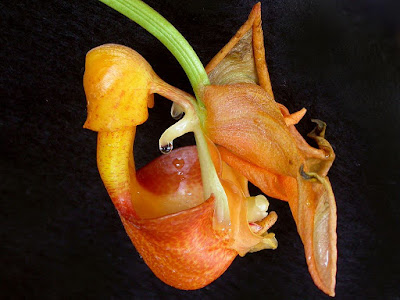Coryanthes speciosa is widespread from the Yucatán Peninsula in Mexico to the south through Guatemala, Honduras, Costa Rica, Panama, Trinidad, Venezuela, Guyana, Brazil, Colombia and Peru...
Coryanthes speciosa also called as The Outstanding Coryanthes, Coryanthes albertinae, Coryanthes barkeri, Coryanthes maculata, Coryanthes maculata, Coryanthes maculata var. punctata, Coryanthes maculata var. splendens, Coryanthes maculata var. vitrina, Coryanthes powellii, Coryanthes punctata, Coryanthes splendens, Coryanthes speciosa f. punctata, Coryanthes speciosa f. sumneriana, Coryanthes speciosa var alba, Coryanthes speciosa var. espritosantense, Coryanthes speciosa var exima, Coryanthes speciosa var. punctata, Coryanthes speciosa var. sumneriana, Coryanthes speciosa var vitellina, Coryanthes sumneriana, Epidendrum galeatum, Gongora macrantha, Gongora speciosa, Meliclis speciosa, is a species of the genus Coryanthes. This species was described by William Jackson Hooker in 1831.
IDENTIFY CORYANTHES SPECIOSA
Coryanthes speciosa is widespread from the Yucatán Peninsula in Mexico to the south through Guatemala, Honduras, Costa Rica, Panama, Trinidad, Venezuela, Guyana, Brazil, Colombia and Peru. These plants grow as epiphytes in low, hot and humid regions, usually at an altitude of less than 1000 m. Strict environmental information is not specified, but Coryanthes species are normally found in very acidic environments, usually in ant nests.
It is a large sized, hot growing epiphyte, which reaching 45 cm high, with tall spindly, rugose, 7-15 cm long pseudobulbs carrying 2, apical, narrowly elliptic, 35-55 cm long leaves.
The Outstanding Coryanthes blooms in the summer on a basal, pendant, 45 cm long, bracteate, 1 to several flowered, racemose inflorescence arising on a mature pseudobulb and has a waxy, large flower that is quite fragrant, smelling of mint and is held well below the plant. The flowers are 13 cm in diameter. The color of the flowers is varied, but most often yellow-brown, strongly covered with maroon flecking. The petals are usually pale brown, with spots of varying sizes, from small to large. The very complex lip is yellowish and yellow-brown.
CORYANTHES SPECIOSA CARE AND CULTURE
Cultural information should only be used as a guide, and should be to be adapted to suit you. Your physical location; where you grow your plants, how much time you have to devote to their care, and many other factors, will need to be taken into account. Only then can you decide on the cultural methods that best suit you and your plants.
Light:
Coryanthes speciosa needs a light level of 18000-25000 lux.
Temperature:
It is a thermophilic plant. Throughout the year, the average day temperatures is 27-29 ° C , average night 18-20 ° C , and the amplitude of fluctuations of temperature is 7-9 ° C .
Humidity:
The Outstanding Coryanthes needs the humidity of about 80% throughout the year.
Substrate, growing media and repotting:
Suspended baskets are required because the inflorescence of Coryanthes speciosa is sagging and appears at the base of the plant, breaking down through the ground. It is recommended to use a very acidic and humidifying substrate.
The plants grow extremely well if planted in cut-up redwood bark and in a still moist soil. Ant nests in which the plant grows in nature contain large amounts of formic acid and have a pH value of about 3. The redwood bark, also at pH 3, is the only commonly available potting substrate with a sufficiently low pH that meets these requirements.
Watering:
Rainfall for most of the year is intense with 2-3 months slightly drier period lasting at the end of summer and early autumn. In the period of strong growth, the growing medium should be moist.
Fertilizer:
The plants should be fertilized every week 1/4-1/2 of the recommended dose of fertilizer for orchids. A fertilizer with a high nitrogen content is beneficial from spring to mid-summer, and a fertilizer richer in phosphorus should be used in late summer and autumn.
Rest period:
In winter, the amount of water should be slightly reduced, especially if the Coryanthes speciosa are grown in dark, short days, which occurs in moderate latitudes. However, do not allow them to completely dry out. Fertilization should be limited or should be completely abandoned until spring, when stronger watering resumes.















COMMENTS